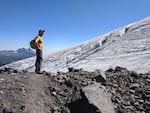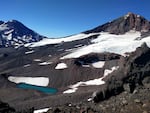A new analysis finds that Oregon has now lost nearly 30% of its named glaciers since the mid-1900s.
The findings by the recently-founded Oregon Glaciers Institute were displayed this month at the American Geophysical Union’s fall meeting. Author Aaron Hartz says the study marks the beginning of an ongoing glacier monitoring program. Oregon’s glaciers were first mapped in the 1950s by the U.S. Geological Survey.
“We know that the glaciers have changed quite a bit since then,” said Hartz, whose institute formed this year to conduct science and public education around glacier loss.
Most of Oregon’s named glaciers are found on Mount Hood and South Sister in the Cascades.
A glacier is a huge chunk of ice that moves and deforms under its own weight. Hartz says the ice needs to be about 100 feet thick to trigger this motion.

Anders Carlson, the president and chief scientist of the Oregon Glaciers Institute, pictured near the terminus of Hayden Glacier on the Middle Sister in Oregon's central Cascades.
Aaron Hartz
“If it gets much thinner than that, it’s probably not going to be an active glacier,” he said. “Once we identified… at-risk glaciers, then we went into the field and used visual clues to tell if glaciers were active.”
They looked for things like large cracks in the ice, milky sediment — referred to as glacial flour — in the streams below, and the formation of moraines — collections of boulders, rocks and sand that are transported and deposited by the moving ice.
As part of the work, Hartz not only reassessed the status of glaciers that had been identified and named by the USGS, but also identified and included other historic and unnamed glaciers.
“Oftentimes permanent snowfields will not be named, but you do see them on the map. The difference is that a permanent snowfield doesn’t really have ice that’s moving or deforming,” Hartz said. “In some cases, when we were out in the field, we came across areas where there were fairly recent moraines.”
This indicated that the snowfields were at one time active glaciers. Most of the unnamed glaciers identified in the paper were located in the Wallowas of northeastern Oregon.
When considering the totality of named and unnamed glaciers, Hartz and his research partner estimated that about 50% from the past two centuries are no longer active.
The authors correlate the losses to reductions in the snowpack as well as increases in annual and summertime temperatures over the past three decades, although the processes that contribute to glacial losses can be complex.
These climatic changes in the Pacific Northwest are expected to amplify further as humans pump greenhouse gasses like carbon dioxide and methane into the atmosphere through the burning of fossil fuels.
Glacier researcher Mark Carey, director of the environmental studies program at the University of Oregon, says the glaciers in Washington and Oregon have not been the subject of many studies compared to those in other regions.
“Providing a baseline in Oregon that has been overlooked is important. If nothing else it flags all the other questions that might come from this,” he said.
But Carey says those other questions are even more important.
“How much do glaciers in Oregon really matter for downstream communities? For whom do they matter? Why should we be studying them?” Carey asked.
He said glaciers could have implications for water supplies, mountain hazards, stream temperatures, recreation and tourism.
Study author Hartz says the Oregon Glaciers Institute intends to continue monitoring in the coming years to more fully document the status of the state’s glaciers.

The Hayden and Diller Glaciers on Middle Sister in the Oregon Cascades continue to be active glaciers.
Aaron Hartz



